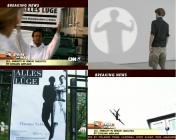|
 |
Sonntag, 21. November 2004 |
Newspapers on your mobile. People
sick of manhandling large newspapers on their way to work will soon be
able to view the days headlines on their mobile phone, reports Moconews.
Mobile Dreams Factory has released a program named MicroEditions , which reformats newspaper headlines for multimedia phones.
works on 52 different models, and works by obtaining the content,
reformats it for each model and delivering them to the operator to be
downloaded by the user.
[Eyebeam reBlog]
8:35:56 PM 
|
|
History of SMS, Early Wireless Communications.
The 100th anniversary issue of a an English language Norwegian journal
called Telektronikk has some fascinating articles on the development of
GSM and mobile communication, including a history of SMS. H ken Lie
(one of the fellows that developed... [Eyebeam reBlog]
8:34:38 PM 
|
|
starbucks uk. Some
things are completely international. I'm in a Starbucks 5 mins from our
house, sipping an eggnog latté (upgraded to mega size 'cause they're
out of 'grandé' cups) downloading email attachments on the in-store
wi-fi.
Couple of quick skype calls and ofcourse an ipodder scan.
Life in the old country is going to suit me just fine..... [Adam Curry: Adam Curry's Weblog]
5:18:09 PM 
|
|
The Cochineal. Japanese
media artist Noboru Tsubaki's work Cochineal is a machine to patrol
cyber-terrorism. The large fiberglass insect lures visitors into its
"web".
They step inside the spaceship, wearing a suit embedded with sensors,
and physically feel the attack of virus just as if they were insects on
their skin. Visitors can destroy the worm by pushing a button. But,
just like in the real world, simply killing it does not solve the
problem as the more and more worms appear, begging to be exterminated.
![PA281539Lg[1].jpg](http://www.we-make-money-not-art.com/yyy/PA281539Lg%5B1%5D.jpg)
"With Cochineal, I wish to realistically represent the potential
harm of a computer virus, or worm. We tend to adopt technological
innovations without considering their long-term implications", says
Tsubaki. "and we still choose to depend upon them, though they
undoubtedly put us at risk. Through Cochineal, I wish to put forth a
more realistic representation of these threats".
Details in Derivative. [we make money not art]
1:19:58 PM 
|
|
Manipulating our own shadow. The installation lies, all lies ,
by Hannes Nehls, tries to create an awareness for media made
manipulations by manipulating the "ultimate" picture: our own shadow.
After the visitor has stepped into floodlighting, s/he recognizes
her/his own shadow on the wall. But then this shadow suddenly moves for
no apparent reason: software, data projectors, infra-red floodlights
and infra-red sensitive video cameras simulate the shadow, which is
alway genuine, and thus render it open to manipulation.

The installation questions our perception for figurative information and thus makes visible the inherent manipulation.
In Basel, at the VIPER festival till November 22. [we make money not art]
1:19:01 PM 
|
|
9/11 and the age of the prosumer.  Twenty-five years after Alvin Toffler coined the term "Prosumer" in his
book The Third Wave, Consumer Anthropologist Robbie Blinkoff says the
Prosumer is officially here to stay and that this holiday season is
their coming of age. "Think of it as the coming out party for a new
species, an evolution in a consumer mindset. It is now the producers -
companies, manufacturers, marketers and retailers, who need to adapt,"
said Blinkoff.
Twenty-five years after Alvin Toffler coined the term "Prosumer" in his
book The Third Wave, Consumer Anthropologist Robbie Blinkoff says the
Prosumer is officially here to stay and that this holiday season is
their coming of age. "Think of it as the coming out party for a new
species, an evolution in a consumer mindset. It is now the producers -
companies, manufacturers, marketers and retailers, who need to adapt,"
said Blinkoff. A Prosumer is part producer part consumer.
Prosumers are engaged in a creative process of producing a product and
service portfolio with guidance from trusted friends - the companies
they've trusted for years and the new ones they've come to love.
Certainly Toffler's prophesy was becoming a reality with mass computer
consumption, Internet, Cable TV and digital technologies available, but
Blinkoff, a Principal Anthropologist at Context-Based Research Group in
Baltimore, says something dramatic happened to the Prosumer landscape
that sped up the evolutionary process. That monumental event was 9/11. (RED NOVA)
[Eyebeam reBlog]
1:18:03 PM 
|
|
The collabowobble.

" Collabolla"
(aka collabowobble) is a videogame where you have to sit astride an
inflatable ball (like the '70s "Spacehopper" balls) bounce, rock back
and forth, roll or jump around to send commands to the computer.
The two players don't play against each other but have to join
forces and co-ordinate with each other to control the same character's
movement and combat a common enemy.
The joystick is replaced by the balls: one for the x axis and one
for the y axis, one moving pacman up and down, and the other left and
right.
This is only a prototype, by Jennifer L. Bove, Simone Pia and
Nathan Waterhouse, but I'll cherish the one who would manufacture and
sell it.
[Eyebeam reBlog]
1:17:02 PM 
|
|
The stress watch.

The Avidus watch accentuates the way that time seem to pass more quickly or more slowly depending on our mood.
If we are in a hurry, time seems to pass so fast. But when we are relaxed (or bored), it appears to slow down.
Two metal contacts on the watch face measure your stress level. If
you're stressed and touch the watch then the hour displayed runs
forwards, the more stressed the faster. If you're totally relaxed, the
time can even run backwards.
Avidus is one of the 7 amazing Mr Jones Watches that were designed by Crispin Jones. They were produced as one-off working timepieces, but a possible commercial production is under study.
[Eyebeam reBlog]
1:16:20 PM 
|
|
© Copyright 2005 Joerg Rheinboldt.
|
|
|
